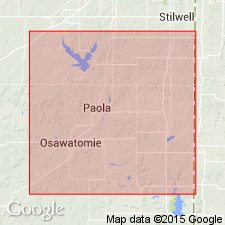
- Usage in publication:
-
- Einstine sandstone
- Modifications:
-
- Original reference
- AAPG geologic province:
-
- Forest City basin
Summary:
Pg. 7. Einstine sandstone. Thin beds of soft brown micaceous and hard gray calcareous ripple-marked sandstones more or less intercalated with and passing into blue and brown sandy argillaceous shales. Upper part marly and fossiliferous at McFaddin's and at Ward's mill. Forms bed No. 10 (35 to 60 feet thick) of geologic section of Miami County, eastern Kansas. Overlain by Cave limestone and underlain by older Coal Measures strata. Age is Pennsylvanian.
Origin of name not stated.
Source: US geologic names lexicon (USGS Bull. 896, p. 664).

- Usage in publication:
-
- Einstine sandstone
- Einstein sandstone
- Modifications:
-
- Overview
- AAPG geologic province:
-
- Forest City basin
Summary:
In later reports [post Swallow and Hawn] called "Einstein sandstone" and included, together with †Cave limestone, in †Cave Rock series. Probably represents whole or part of Chanute shale member of Kansas City formation.
Source: US geologic names lexicon (USGS Bull. 896, p. 664).
For more information, please contact Nancy Stamm, Geologic Names Committee Secretary.
Asterisk (*) indicates published by U.S. Geological Survey authors.
"No current usage" (†) implies that a name has been abandoned or has fallen into disuse. Former usage and, if known, replacement name given in parentheses ( ).
Slash (/) indicates name conflicts with nomenclatural guidelines (CSN, 1933; ACSN, 1961, 1970; NACSN, 1983, 2005, 2021). May be explained within brackets ([ ]).

